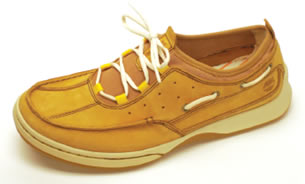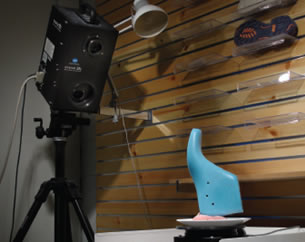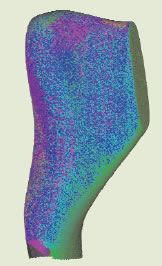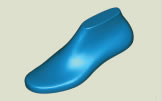Shape Sampling For a Better Fit
Timberland uses Geomagic digital shape sampling and processing to reinvent footwear manufacturing.
Latest News
September 16, 2007
By Bob Cramblitt
 The Timberland Block Island shoe was designed around a last digitally scanned and used to create a 3D model. The Block Island model debuted in December 2006 in Canada and North America, followed by Europe in February 2007, and Asia in April 2007. |
Timberland is a cultural icon, a dream brand. The nickname “Timbs” is name-checked on dozens of hip-hop lyrics, and one of the genre’s best-selling producers, Timbaland, was given the handle because of his penchant for wearing the company’s footwear. On the corporate side, Timberland’s commitment to social responsibility is respected and emulated worldwide.
Amid all this, it’s easy to forget that Timberland is also a manufacturing innovator. In the 1960s, the Stratham, NH, company introduced injection molding to the footwear industry, fusing soles to leather uppers without stitching.
Now the latest innovation from the nearly 90-year-old company is taking place behind the scenes: Timberland is using digital shape sampling and processing (DSSP) technology from Geomagic of Research Triangle Park, NC, for greater footwear customization, faster time to market, more consistent quality, and manufacturing with considerably less waste.
It might not be the stuff that inspires rappers’ rhymes, but it could well mark a turning point in how shoes are designed and manufactured in a global enterprise.
Lasts different from the past
Since ancient times, shoes have been designed and made using lasts, or molds that approximate the form of the human foot. Traditionally these were made of wood, but now they are generally manufactured from blocks of plastic milled by CNC machines.
Timberland currently produces between 100 and 120 lasts per year across its major product lines of Outdoor Performance, Authentic Youth, Industrial-PRO, and Casual Gear. Until two years ago, all lasts were created and modified by hand, then shipped to the company’s manufacturing facility in the Dominican Republic or to Asian partners in Thailand, Vietnam, and China. Incorrect and outdated lasts were thrown away, unless they were newer ones made with polypropylene, which can be recycled.
With the new DSSP process, handmade lasts represent only 10 percent of Timberland lasts used for design and manufacturing. Reworks, a frequent occurrence with handmade lasts, have been reduced by 75 percent, according to Terry Anderson, a Timberland last engineer.
 Timberland begins the digital shape sampling and processing task by scanning an existing shoe last with a Konica-Minolta Vivid 9i scanner. |
“We can now visualize a last before it is used to make a shoe, and if needed, create a rapid physical prototype within three-to-four hours for a design and engineering review,” says Anderson. “Material waste has been drastically reduced, and we’ve eliminated the chemical fillers we used for sculpting new shapes.”
Hand craft meets the digital age
Timberland has made the transition to its new last production process in just over two years by implementing DSSP, a collection of technology components that enables users to quickly create accurate digital models of complex physical objects.
At Timberland, the process of creating a completely new last starts the way it has for decades: A concept is specified by the product design team, usually based on an existing last that has worked well. An in-house last engineer creates the first iteration by hand.
“The engineer cuts, fills, and adjusts the shape, keeping in mind the balance of key fit points and design aesthetics,” says Toby Ringdahl, CAD manager for global footwear development at Timberland.
Once the initial form has been developed, the last is scanned with a Konica-Minolta Vivid 9i laser scanner. The scanner captures the shape of the last in thousands of 3D points, with resolution up to +0.008 millimeters. A turntable controlled by
Geomagic software helps automate and speed up the process. Multiple scans are made to capture the complex curves of the last. For most lasts, scanning takes about 20 minutes.
From physical to digital
Point-cloud data from the scanner is brought into Geomagic Studio digital reconstruction software, which automatically aligns the multiple scans. A module called Wrap eliminates time-consuming surface reconstruction work by mathematically wrapping a polygonal surface around the point-cloud data.
 Manual registration tools in Geomagic Studio are used to fine-tune the digital model. Timberland uses automated features in the software to quickly fill holes and remove blemishes while maintaining surface curvature, and to reconstruct sharp or creased edges lost during scanning. |
Geomagic Studio then provides intelligent data filtering to preserve features and minimize visual noise from the 3D model. Timberland uses automated features in the software to quickly fill holes and remove blemishes while maintaining surface curvature, and to reconstruct sharp or creased edges lost during scanning.
The Geomagic process typically takes around another 20 minutes. From scanning to digital reconstruction, a precise digital replica of a last is produced in about an hour. A more complex object, such as an entire shoe with many more features and details, can take three or four hours, according to Doug Maughan, a Timberland 3D technology specialist.
Better fit and feel
Once basic lasts are captured in digital form, the design, prototyping, and manufacturing possibilities — and benefits — are seemingly endless.
Anderson says 3D digital data exchange with manufacturers improves overall quality of the final product.
 The next step is to use the automated global registration capability in Geomagic Studio to align the different scans of the shoe last. |
“Our goal is to standardize fitting and grading with our manufacturers,” Maughan says. “With DSSP, we have a direct link to those manufacturers. This leaves less chance for error, as we are sending the exact data directly to them.”
Adds Ringdahl: “Our new lasts are often based on proven lasts that we know fit well and are suitable for manufacturing. DSSP and rapid prototyping has helped us create a consistent fit and feel to our footwear. The heel area that is so critical for fit, for example, can be maintained while the forefoot shape is modified to address a fashion or specific end use.”
Quick modification, no shipping
Ringdahl says the biggest time savings comes from being able to modify lasts quickly, and by digitally transferring 3D last files to overseas factories instead of shipping physical products.
With DSSP, modified versions of existing or historical lasts can be created based on models from Timberland’s quickly growing digital archive, which now contains more than 500 designs. Design conceptualization can be done in minutes by making changes to the 3D model. In cases where a physical prototype of a last, shoe part, or an entire shoe is needed, Timberland sends the Geomagic data to a Z Corporation Spectrum 510 rapid prototyping system, which can produce a realistic physical model for design and engineering review in three or four hours.”
More options and easy archiving
Timberland is finding that DSSP is a vehicle for exploring the type of eclectic designs and customization that defines brands in today’s consumer market.
“We can physically replicate three or four new styles a day,” says Anderson. “With our old way of developing lasts it would take up to two weeks to produce a single physical prototype. With the digital model, we can look at and quickly explore many more design options and aesthetics, such as top-down view, center silhouette profile, bottom shape, toe character, heel height, toe spring, footbed-chassis thickness, and boot- or low-cut profiles.”
 A new digital shoe last based on the scan data of the physical model is typically created in Geomagic Studio within 20 minutes. The entire digital reconstruction process — from scanning to a precise new digital model — usually takes about an hour. |
At the back end of the process is archiving, formerly a process involving a lot of manual labor and physical space to store and retrieve hundreds of historical lasts. Now, Timberland transfers the Geomagic 3D models of lasts to an electronic library managed using 3Shape software. 3Shape provides a structured database, search and browsing functions, and an archival display of all relevant information.
“We now have a searchable database with version control and better tracking of metadata, such as development notes, measurements, and other information necessary to ensure design and manufacturing accuracy,” says Ringdahl.
Timberland is one of the companies blazing a new path toward mass customization in consumer product development.
“It’s not a black-and-brown shoe world anymore,” says Ping Fu, president and CEO of Geomagic. “Timberland is blending technology and design to make authentic products tailored to specific tastes and different local cultures around the world. That’s the future of manufacturing in the 21st century.”
Bob Cramblitt owns Cramblitt & Company in Cary, NC, and writes about design, engineering, and IT technologies. Send e-mail about this article to DE-Editorsmailto:[email protected].
Subscribe to our FREE magazine, FREE email newsletters or both!
Latest News
About the Author
DE’s editors contribute news and new product announcements to Digital Engineering.
Press releases may be sent to them via [email protected].






